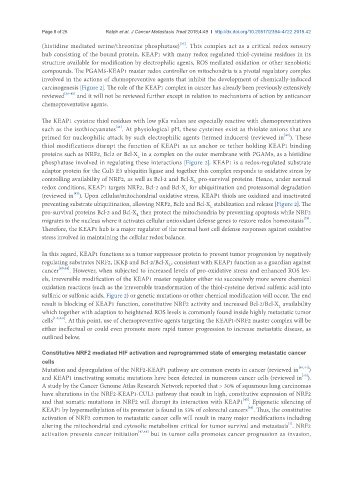Page 588 - Read Online
P. 588
Page 8 of 26 Ralph et al. J Cancer Metastasis Treat 2018;4:49 I http://dx.doi.org/10.20517/2394-4722.2018.42
[35]
(histidine mediated serine/threonine phosphatase) . This complex act as a critical redox sensory
hub consisting of the bound protein, KEAP1 with many redox regulated thiol-cysteine residues in its
structure available for modification by electrophilic agents, ROS mediated oxidation or other xenobiotic
compounds. The PGAM5-KEAP1 master redox controller on mitochondria is a pivotal regulatory complex
involved in the actions of chemopreventive agents that inhibit the development of chemically-induced
carcinogenesis [Figure 2]. The role of the KEAP1 complex in cancer has already been previously extensively
reviewed [36-40] and it will not be reviewed further except in relation to mechanisms of action by anticancer
chemopreventative agents.
The KEAP1 cysteine thiol residues with low pKa values are especially reactive with chemopreventatives
[41]
such as the isothiocyanates . At physiological pH, these cysteines exist as thiolate anions that are
[42]
primed for nucleophilic attack by such electrophilic agents (termed inducers) (reviewed in ). These
thiol modifications disrupt the function of KEAP1 as an anchor or tether holding KEAP1 binding
proteins such as NRF2, Bcl2 or Bcl-X in a complex on the outer membrane with PGAM5, as a histidine
L
phosphatase involved in regulating these interactions [Figure 2]. KEAP1 is a redox-regulated substrate
adaptor protein for the Cul3 E3 ubiquitin ligase and together this complex responds to oxidative stress by
controlling availability of NRF2, as well as Bcl-2 and Bcl-X pro-survival proteins. Hence, under normal
L
redox conditions, KEAP1 targets NRF2, Bcl-2 and Bcl-X for ubiquitination and proteasomal degradation
L
[43]
(reviewed in ). Upon cellular/mitochondrial oxidative stress, KEAP1 thiols are oxidized and inactivated
preventing substrate ubiquitination, allowing NRF2, Bcl2 and Bcl-X stabilization and release [Figure 2]. The
L
pro-survival proteins Bcl-2 and Bcl-X then protect the mitochondria by preventing apoptosis while NRF2
L
[29]
migrates to the nucleus where it activates cellular antioxidant defense genes to restore redox homeostasis .
Therefore, the KEAP1 hub is a major regulator of the normal host cell defense responses against oxidative
stress involved in maintaining the cellular redox balance.
In this regard, KEAP1 functions as a tumor suppressor protein to prevent tumor progression by negatively
regulating substrates NRF2, IKKβ and Bcl-2/Bcl-X , consistent with KEAP1 function as a guardian against
L
cancer [40,44] . However, when subjected to increased levels of pro-oxidative stress and enhanced ROS lev-
els, irreversible modification of the KEAP1 master regulator either via successively more severe chemical
oxidation reactions (such as the irreversible transformation of the thiol-cysteine derived sulfenic acid into
sulfinic or sulfonic acids, Figure 2) or genetic mutations or other chemical modification will occur. The end
result is blocking of KEAP1 function, constitutive NRF2 activity and increased Bcl-2/Bcl-X availability
L
which together with adaption to heightened ROS levels is commonly found inside highly metastatic tumor
cells [1-3,5,6] . At this point, use of chemopreventive agents targeting the KEAP1-NRF2 master complex will be
either ineffectual or could even promote more rapid tumor progression to increase metastatic disease, as
outlined below.
Constitutive NRF2 mediated HIF activation and reprogrammed state of emerging metastatic cancer
cells
Mutation and dysregulation of the NRF2-KEAP1 pathway are common events in cancer (reviewed in [40,44] )
[40]
and KEAP1 inactivating somatic mutations have been detected in numerous cancer cells (reviewed in ).
A study by the Cancer Genome Atlas Research Network reported that > 30% of squamous lung carcinomas
have alterations in the NRF2-KEAP1-CUL3 pathway that result in high, constitutive expression of NRF2
[45]
and that somatic mutations in NRF2 will disrupt its interaction with KEAP1 . Epigenetic silencing of
[46]
KEAP1 by hypermethylation of its promoter is found in 53% of colorectal cancers . Thus, the constitutive
activation of NRF2 common to metastatic cancer cells will result in many major modifications including
[7]
altering the mitochondrial and cytosolic metabolism critical for tumor survival and metastasis . NRF2
activation prevents cancer initiation [47,48] but in tumor cells promotes cancer progression as invasion,

